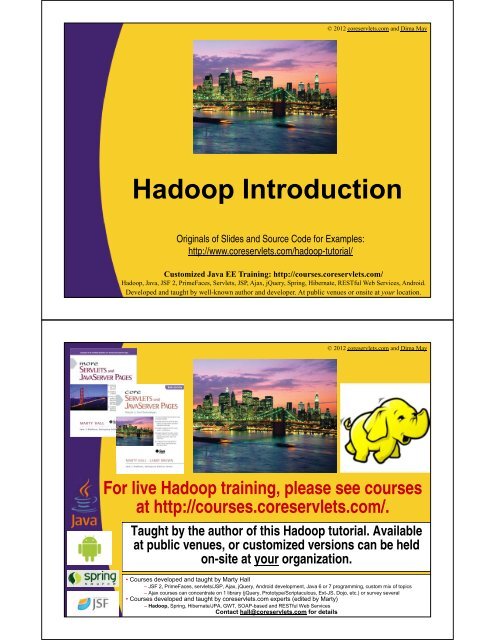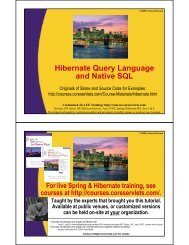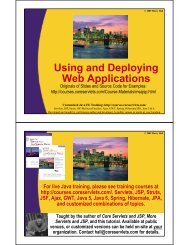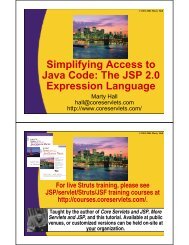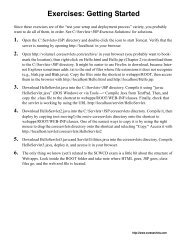Download - Custom Training Courses - Coreservlets.com
Download - Custom Training Courses - Coreservlets.com
Download - Custom Training Courses - Coreservlets.com
Create successful ePaper yourself
Turn your PDF publications into a flip-book with our unique Google optimized e-Paper software.
© 2012 coreservlets.<strong>com</strong> and Dima MayHadoop IntroductionOriginals of Slides and Source Code for Examples:http://www.coreservlets.<strong>com</strong>/hadoop-tutorial/<strong>Custom</strong>ized Java EE <strong>Training</strong>: http://courses.coreservlets.<strong>com</strong>/Hadoop, Java, JSF 2, PrimeFaces, Servlets, JSP, Ajax, jQuery, Spring, Hibernate, RESTful Web Services, Android.Developed and taught by well-known author and developer. At public venues or onsite at your location.© 2012 coreservlets.<strong>com</strong> and Dima MayFor live Hadoop training, please see coursesat http://courses.coreservlets.<strong>com</strong>/.Taught by the author of this Hadoop tutorial. Availableat public venues, or customized versions can be heldon-site at your organization.• <strong>Courses</strong> developed and taught by Marty Hall– JSF 2, PrimeFaces, servlets/JSP, Ajax, jQuery, Android development, Java 6 or 7 programming, custom mix of topics– Ajax courses <strong>Custom</strong>ized can concentrate Java on 1 EE library <strong>Training</strong>: (jQuery, Prototype/Scriptaculous, http://courses.coreservlets.<strong>com</strong>/Ext-JS, Dojo, etc.) or survey several• <strong>Courses</strong> developed and taught by coreservlets.<strong>com</strong> experts (edited by Marty)Hadoop, Java, JSF 2, PrimeFaces, Servlets, JSP, Ajax, jQuery, Spring, Hibernate, RESTful Web Services, Android.– Hadoop, Spring, Hibernate/JPA, GWT, SOAP-based and RESTful Web ServicesDeveloped and taught by well-known Contact author hall@coreservlets.<strong>com</strong> and developer. At public for details venues or onsite at your location.
Agenda• Big Data• Hadoop Introduction• History• Comparison to Relational Databases• Hadoop Eco-System and Distributions• Resources4Big Data• Information Data Corporation (IDC)estimates data created in 2010 to be1.2 ZETTABYTES(1.2 Trillion Gigabytes)• Companies continue to generate largeamounts of data, here are some 2011 stats:– Facebook ~ 6 billion messages per day– EBay ~ 2 billion page views a day, ~ 9 Petabytes ofstorage– Satellite Images by Skybox Imaging ~ 1 Terabyte per day5Sources:"Digital Universe" study by IDC; http://www.emc.<strong>com</strong>/leadership/programs/digital-universe.htmHadoop World 2011 Keynote: Hugh E. Williams, eBayHadoop World 2011: Building Realtime Big Data Services at Facebook with Hadoop and HBaseHadoop World 2011: Indexing the Earth – Large Scale Satellite Image Processing Using Hadoop
Hadoop• Existing tools were not designed to handlesuch large amounts of data• "The Apache Hadoop project developsopen-source software for reliable, scalable,distributed <strong>com</strong>puting." -http://hadoop.apache.org– Process Big Data on clusters of <strong>com</strong>modity hardware– Vibrant open-source <strong>com</strong>munity– Many products and tools reside on top of Hadoop6Hadoop Jobs7 Source: http://www.indeed.<strong>com</strong>/jobanalytics/jobtrends?q=cloud+<strong>com</strong>puting%2C+hadoop%2C+jpa%2C+ejb3&l=
Who Uses Hadoop?8Source: http://wiki.apache.org/hadoop/PoweredByData Storage• Storage capacity has grown exponentiallybut read speed has not kept up– 1990:• Store 1,400 MB• Transfer speed of 4.5MB/s• Read the entire drive in ~ 5 minutes– 2010:• Store 1 TB• Transfer speed of 100MB/s• Read the entire drive in ~ 3 hours• Hadoop - 100 drives working at the sametime can read 1TB of data in 2 minutes9
Hadoop Clusterclient client clientHadoop Cluster10Hadoop Cluster• A set of "cheap" <strong>com</strong>modity hardware• Networked together• Resides in the same location– Set of servers in a set of racks in a data center11
Use Commodity Hardware• “Cheap” Commodity Server Hardware– No need for super-<strong>com</strong>puters, use <strong>com</strong>modity unreliablehardware– Not desktopsNOTBUT12Hadoop System Principles• Scale-Out rather than Scale-Up• Bring code to data rather than data to code• Deal with failures – they are <strong>com</strong>mon• Abstract <strong>com</strong>plexity of distributed andconcurrent applications13
Scale-Out Instead of Scale-Up• It is harder and more expensive to scale-up– Add additional resources to an existing node (CPU, RAM)– Moore’s Law can’t keep up with data growth– New units must be purchased if required resources can not beadded– Also known as scale vertically• Scale-Out– Add more nodes/machines to an existing distributedapplication– Software Layer is designed for node additions or removal– Hadoop takes this approach - A set of nodes are bondedtogether as a single distributed system– Very easy to scale down as well14Code to Data• Traditional data processing architecture– nodes are broken up into separate processing and storagenodes connected by high-capacity link– Many data-intensive applications are not CPU demandingcausing bottlenecks in networkProcessingNodeProcessingNodeLoad DataSave ResultsLoad DataSave ResultsStorageNodeStorageNodeRisk of bottleneck
Code to Data• Hadoop co-locates processors and storage– Code is moved to data (size is tiny, usually in KBs)– Processors execute code and access underlying localstorageHadoop ClusterProcessorStorageHadoop NodeProcessorStorageProcessorStorageHadoop NodeProcessorStorage16Hadoop NodeHadoop NodeFailures are Common• Given a large number machines, failures are<strong>com</strong>mon– Large warehouses may see machine failures weekly oreven daily• Hadoop is designed to cope with nodefailures– Data is replicated– Tasks are retried17
Abstract Complexity• Hadoop abstracts many <strong>com</strong>plexities indistributed and concurrent applications– Defines small number of <strong>com</strong>ponents– Provides simple and well defined interfaces of interactionsbetween these <strong>com</strong>ponents• Frees developer from worrying about systemlevelchallenges– race conditions, data starvation– processing pipelines, data partitioning, code distribution– etc.• Allows developers to focus on applicationdevelopment and business logic18History of Hadoop• Started as a sub-project of Apache Nutch– Nutch’s job is to index the web and expose it for searching– Open Source alternative to Google– Started by Doug Cutting• In 2004 Google publishes Google File System(GFS) and MapReduce framework papers• Doug Cutting and Nutch team implementedGoogle’s frameworks in Nutch• In 2006 Yahoo! hires Doug Cutting to work onHadoop with a dedicated team• In 2008 Hadoop became Apache Top LevelProject– http://hadoop.apache.org19
Naming Conventions?• Doug Cutting drew inspiration from hisfamily– Lucene: Doug’s wife’s middle name– Nutch: A word for "meal" that his son used as a toddler– Hadoop: Yellow stuffed elephant named by his son20Comparisons to RDBMS21• Until recently many applications utilizedRelational Database Management Systems(RDBMS) for batch processing– Oracle, Sybase, MySQL, Microsoft SQL Server, etc.– Hadoop doesn’t fully replace relational products; manyarchitectures would benefit from both Hadoop and aRelational product(s)• Scale-Out vs. Scale-Up– RDBMS products scale up• Expensive to scale for larger installations• Hits a ceiling when storage reaches 100s of terabytes– Hadoop clusters can scale-out to 100s of machines and topetabytes of storage
Comparisons to RDBMS (Continued)22• Structured Relational vs. Semi-Structuredvs. Unstructured– RDBMS works well for structured data - tables thatconform to a predefined schema– Hadoop works best on Semi-structured and Unstructureddata• Semi-structured may have a schema that is looselyfollowed• Unstructured data has no structure whatsoever and isusually just blocks of text (or for example images)• At processing time types for key and values are chosen bythe implementer– Certain types of input data will not easily fit intoRelational Schema such as images, JSON, XML, etc...Comparison to RDBMS• Offline batch vs. online transactions– Hadoop was not designed for real-time or low latencyqueries– Products that do provide low latency queries such asHBase have limited query functionality– Hadoop performs best for offline batch processing onlarge amounts of data– RDBMS is best for online transactions and low-latencyqueries– Hadoop is designed to stream large files and largeamounts of data– RDBMS works best with small records23
Comparison to RDBMS• Hadoop and RDBMS frequently <strong>com</strong>plementeach other within an architecture• For example, a website that– has a small number of users– produces a large amount of audit logs2Web Server 13RDBMS Hadoop41Utilize RDBMS to provide rich UserInterface and enforce data integrity3All logs are kept in Hadoop; Variousanalytics are executed periodically242RDBMS generates large amounts of auditlogs; the logs are moved periodically tothe Hadoop cluster4Results copied to RDBMS to be usedby Web Server; for example"suggestions" based on audit historyHadoop Eco System• At first Hadoop was mainly known for two coreproducts:– HDFS: Hadoop Distributed FileSystem– MapReduce: Distributed data processing framework• Today, in addition to HDFS and MapReduce, theterm also represents a multitude of products:– HBase: Hadoop column database; supports batch and randomreads and limited queries– Zookeeper: Highly-Available Coordination Service– Oozie: Hadoop workflow scheduler and manager– Pig: Data processing language and execution environment– Hive: Data warehouse with SQL interface25
Hadoop Eco System• To start building an application, you need a filesystem– In Hadoop world that would be Hadoop Distributed File System(HDFS)– In Linux it could be ext3 or ext4• Addition of a data store would provide a nicerinterface to store and manage your data– HBase: A key-value store implemented on top of HDFS– Traditionally one could use RDBMS on top of a local file systemHBase26Hadoop Distributed FileSystem (HDFS)Hadoop Eco System• For batch processing, you will need toutilize a framework– In Hadoop’s world that would be MapReduce– MapReduce will ease implementation of distributedapplications that will run on a cluster of <strong>com</strong>modityhardwareMapReduceHBase27Hadoop Distributed FileSystem (HDFS)
Hadoop Eco System• Many problems lend themselves to aMapReduce solution with multiple jobs– Apache Oozie is a popular MapReduce workflow andcoordination productOozieMapReduceHBase28Hadoop Distributed FileSystem (HDFS)Hadoop Eco System• MapReduce paradigm may not work well foranalysts and data scientists– Addition of Apache Pig, a high-level data flow scriptinglanguage, may be beneficialOoziePigMapReduceHBase29Hadoop Distributed FileSystem (HDFS)
Hadoop Eco System• Your organization may have a good numberof SQL experts– Addition of Apache Hive, a data warehouse solution thatprovides a SQL based interface, may bridge the gapOozie Pig HiveMapReduceHBase30Hadoop Distributed FileSystem (HDFS)Hadoop Distributions• Let’s say you go download Hadoop’s HDFS andMapReduce from http://hadoop.apache.org/• At first it works great but then you decide to startusing HBase– No problem, just download HBase fromhttp://hadoop.apache.org/ and point it to your existing HDFSinstallation– But you find that HBase can only work with a previous versionof HDFS, so you go downgrade HDFS and everything still worksgreat• Later on you decide to add Pig– Unfortunately the version of Pig doesn’t work with the version ofHDFS, it wants you to upgrade– But if you upgrade you’ll break HBase...31
Hadoop Distributions• Hadoop Distributions aim to resolve versionin<strong>com</strong>patibilities• Distribution Vendor will– Integration Test a set of Hadoop products– Package Hadoop products in various installation formats• Linux Packages, tarballs, etc.– Distributions may provide additional scripts to executeHadoop– Some vendors may choose to backport features and bugfixes made by Apache– Typically vendors will employ Hadoop <strong>com</strong>mitters so thebugs they find will make it into Apache’s repository32Distribution Vendors• Cloudera Distribution forHadoop (CDH)• MapR Distribution• Hortonworks Data Platform(HDP)• Apache BigTop Distribution• Greenplum HD Data ComputingAppliance33
Cloudera Distribution forHadoop (CDH)• Cloudera has taken the lead on providingHadoop Distribution– Cloudera is affecting the Hadoop eco-system in the sameway RedHat popularized Linux in the enterprise circles• Most popular distribution– http://www.cloudera.<strong>com</strong>/hadoop– 100% open-source• Cloudera employs a large percentage ofcore Hadoop <strong>com</strong>mitters• CDH is provided in various formats– Linux Packages, Virtual Machine Images, and Tarballs34Cloudera Distribution forHadoop (CDH)• Integrates majority of popular Hadoopproducts– HDFS, MapReduce, HBase, Hive, Mahout, Oozie, Pig,Sqoop, Whirr, Zookeeper, Flume• CDH4 is used in this class35
Supported Operating Systems36• Each Distribution will support its own list ofOperating Systems (OS)• Common OS supported– Red Hat Enterprise– CentOS– Oracle Linux– Ubuntu– SUSE Linux Enterprise Server• Please see vendors documentation forsupported OS and version– Supported Operating Systems for CDH4:https://ccp.cloudera.<strong>com</strong>/display/CDH4DOC/Before+You+Install+CDH4+on+a+Cluster#BeforeYouInstallCDH4onaCluster-SupportedOperatingSystemsforCDH4Resources• Apache Hadoop Documentation– http://hadoop.apache.org• Each project will have their owndocumentation artifacts and usually a wiki• Each Hadoop Distribution Vendor providesdocumentation as well:– For example:https://ccp.cloudera.<strong>com</strong>/display/DOC/Documentation37
Resources: BooksHadoop: The Definitive GuideTom White (Author)O'Reilly Media; 3rd Edition (May6, 2012)Hadoop in ActionChuck Lam (Author)Manning Publications; 1st Edition (December, 2010)MapReduce Design PatternsDonald Miner (Author), Adam Shook (Author)O'Reilly Media (November 22, 2012)38Resources: BooksHBase: The Definitive GuideLars George (Author)O'Reilly Media; 1 edition (September 20, 2011)Programming PigAlan Gates (Author)O'Reilly Media; 1st Edition (October, 2011)Hadoop OperationsEric Sammer (Author)O'Reilly Media (October 22, 2012)39
Resources: BooksData-Intensive Text Processing with MapReduceJimmy Lin and Chris Dyer (Authors) (April, 2010)<strong>Download</strong> for FREE:http://lintool.github.<strong>com</strong>/MapReduceAlgorithms/index.htmlProgramming HiveEdward Capriolo, Dean Wampler,Jason Rutherglen (Authors)O'Reilly Media; 1 edition (October, 2012)Hadoop in PracticeAlex Holmes (Author)Manning Publications; (October 10, 2012)40Resources: Your Instructor• Dima May– dimamay@coreservlets.<strong>com</strong>– Email me any time!41
© 2012 coreservlets.<strong>com</strong> and Dima MayWrap-Up<strong>Custom</strong>ized Java EE <strong>Training</strong>: http://courses.coreservlets.<strong>com</strong>/Hadoop, Java, JSF 2, PrimeFaces, Servlets, JSP, Ajax, jQuery, Spring, Hibernate, RESTful Web Services, Android.Developed and taught by well-known author and developer. At public venues or onsite at your location.Summary• We learned about– Data storage needs are rapidly increasing– Hadoop has be<strong>com</strong>e the de-facto standard for handlingthese massive data sets– The Cloudera Distribution for Hadoop (CDH) is the most<strong>com</strong>monly used Hadoop release distribution– There is a number of Hadoop related publicationsavailable43
© 2012 coreservlets.<strong>com</strong> and Dima MayQuestions?JSF 2, PrimeFaces, Java 7, Ajax, jQuery, Hadoop, RESTful Web Services, Android, Spring, Hibernate, Servlets, JSP, GWT, and other Java EE training.<strong>Custom</strong>ized Java EE <strong>Training</strong>: http://courses.coreservlets.<strong>com</strong>/Hadoop, Java, JSF 2, PrimeFaces, Servlets, JSP, Ajax, jQuery, Spring, Hibernate, RESTful Web Services, Android.Developed and taught by well-known author and developer. At public venues or onsite at your location.


